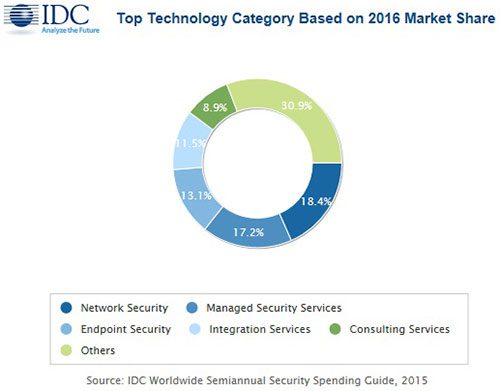Digital transformation is not only modernizing business processes and workstyles, it’s also leading to an increase in security spending. In its latest edition of its Worldwide Semiannual Security Spending Guide, IDC forecast that the global market for security hardware systems, software and services will total $81.7 billion this year, an 8.2-percent increase over 2016. By […]
Datamation content and product recommendations are
editorially independent. We may make money when you click on links
to our partners.
Learn More
Digital transformation is not only modernizing business processes and workstyles, it’s also leading to an increase in security spending.
In its latest edition of its Worldwide Semiannual Security Spending Guide, IDC forecast that the global market for security hardware systems, software and services will total $81.7 billion this year, an 8.2-percent increase over 2016. By 2020, the analyst firm expects that figure to reach nearly $105 billion, representing a compound annual growth rate (CAGR) of 8.7 percent.

As businesses embark on digital transformation, they are adopting Internet of Things (IoT) devices, advanced analytics and other newer technologies that pose tempting targets for attackers. “The rapid growth of digital transformation is putting pressures on companies across all industries to proactively invest in security to protect themselves against known and unknown threats,” said IDC program director Eileen Smith in a statement.
Big spenders include financial firms and factories. “On a global basis, the banking, discrete manufacturing, and federal/central government industries will spend the most on security hardware, software, and services throughout the 2015-2020 forecast,” continued Smith. “Combined, these three industries will deliver more than 30 percent of the worldwide total in 2017.”
Process manufacturers, professional services firms and telecommunications companies are also high on the list of security solutions buyers. Each will spend in excess of $5 billion this year, according to IDC.
Like last year, businesses are flocking to network security hardware and software in 2017. Combined, the category will generate $15.2 billion in sales, earning it the top spot. In comparison, the third-place endpoint security software segment will attract $10.2 billion in revenues this year.
Through 2020, device vulnerability assessment software will be the fastest growing category with a CAGR or 16 percent, followed by software vulnerability assessment products (14.5 percent CAGR). Rounding out the top five are managed security services (12.2 percent CAGR), user behavioral analytics (12.2 percent CAGR) and unified threat management (UTM) hardware (11.9 percent CAGR).
The United States will spend the most on security products this year, to the tune of $36.9 billion. Western Europe is forecast to spend $19.2 billion.
“European organizations show a strong focus on security matters with data, cloud, and mobile security being the top three security concerns,” observed said Angela Vacca, senior research manager of Customer Insights and Analysis at IDC. “In this context, GDPR [General Data Protection Regulation] will drive up compliance-related projects significantly in 2017 and 2018, until organizations have found a cost-efficient and scalable way of dealing with data.”
Pedro Hernandez is a contributing editor at Datamation. Follow him on Twitter @ecoINSITE.
-
Ethics and Artificial Intelligence: Driving Greater Equality
FEATURE | By James Maguire,
December 16, 2020
-
AI vs. Machine Learning vs. Deep Learning
FEATURE | By Cynthia Harvey,
December 11, 2020
-
Huawei’s AI Update: Things Are Moving Faster Than We Think
FEATURE | By Rob Enderle,
December 04, 2020
-
Keeping Machine Learning Algorithms Honest in the ‘Ethics-First’ Era
ARTIFICIAL INTELLIGENCE | By Guest Author,
November 18, 2020
-
Key Trends in Chatbots and RPA
FEATURE | By Guest Author,
November 10, 2020
-
Top 10 AIOps Companies
FEATURE | By Samuel Greengard,
November 05, 2020
-
What is Text Analysis?
ARTIFICIAL INTELLIGENCE | By Guest Author,
November 02, 2020
-
How Intel’s Work With Autonomous Cars Could Redefine General Purpose AI
ARTIFICIAL INTELLIGENCE | By Rob Enderle,
October 29, 2020
-
Dell Technologies World: Weaving Together Human And Machine Interaction For AI And Robotics
ARTIFICIAL INTELLIGENCE | By Rob Enderle,
October 23, 2020
-
The Super Moderator, or How IBM Project Debater Could Save Social Media
FEATURE | By Rob Enderle,
October 16, 2020
-
Top 10 Chatbot Platforms
FEATURE | By Cynthia Harvey,
October 07, 2020
-
Finding a Career Path in AI
ARTIFICIAL INTELLIGENCE | By Guest Author,
October 05, 2020
-
CIOs Discuss the Promise of AI and Data Science
FEATURE | By Guest Author,
September 25, 2020
-
Microsoft Is Building An AI Product That Could Predict The Future
FEATURE | By Rob Enderle,
September 25, 2020
-
Top 10 Machine Learning Companies 2021
FEATURE | By Cynthia Harvey,
September 22, 2020
-
NVIDIA and ARM: Massively Changing The AI Landscape
ARTIFICIAL INTELLIGENCE | By Rob Enderle,
September 18, 2020
-
Continuous Intelligence: Expert Discussion [Video and Podcast]
ARTIFICIAL INTELLIGENCE | By James Maguire,
September 14, 2020
-
Artificial Intelligence: Governance and Ethics [Video]
ARTIFICIAL INTELLIGENCE | By James Maguire,
September 13, 2020
-
IBM Watson At The US Open: Showcasing The Power Of A Mature Enterprise-Class AI
FEATURE | By Rob Enderle,
September 11, 2020
-
Artificial Intelligence: Perception vs. Reality
FEATURE | By James Maguire,
September 09, 2020
SEE ALL
ARTICLES










